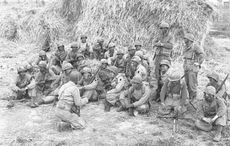The grave of the famous World War I “boy soldier” from Ireland may belong to someone else, claims a Belgian teacher.
Pte John Condon, from Waterford city, was with the 2nd battalion of the Royal Irish Regiment when he was killed at Mouse Trap Farm near Ypres on May 24, 1915.
According to his headstone at Poelcapelle cemetery outside Ypres, he was 14 when he died. The Commonwealth War Graves Commission (CWGC) recognizes him as the youngest British soldier to have died in the war.
Last year, a monument to his memory was unveiled in his native Waterford, and last month, a service was held to mark the 100th anniversary of his death.
However, evidence suggests Condon was 18,not 14, when he died, the Irish Times reports.
His birth certificate states that Condon was born on October 16, 1896. The 1901 census lists him as being 4 years old and the 1911 census as 14.
Aurel Sercu, a retired Belgian schoolteacher who has spent the last 13 years researching Condon, says that he believes the soldier is not buried in grave LVI F8 in Poelcapelle cemetery.
Condon’s remains were found eight years after he died, 3km away from Mouse Trap Farm in Railway Wood.
He was identified by a piece of boot which was stamped with the inscription 6322 4/RIR. The RIR was believed to have stood for the Royal Irish Regiment and Condon’s service number was 6322
However, Sercu believes the boot belonged to Irish-born soldier Rifleman Patrick Fitzsimmons from Raphael Street, Belfast. Fitzsimmons, 35, was serving with the Royal Irish Rifles and was killed three weeks after Condon, on June 16, 1915. He also had the service number 6322.
Because Fitzsimmons enlisted with the 4th battalion of the Royal Irish Rifles (RIR) so 6322 4/RIR would also match his service number, Sercu claims.
On the day Fitzsimmons died, the Royal Irish Rifles were stationed between “Witte Poort Farm and railway,” where the body that is in Condon’s grave was located in 1923.
Fitzsimmons, whose remains were never identified, died during what became known as the Battle of Bellewaarde. The Royal Irish Rifles suffered more than 300 casualties that day, in an assault on the German trenches which was met with a “terrific artillery bombardment.”
Sercu has spent years trying to track down Fitzsimmons' relatives. He finally got in contact with Kenneth Hanna, a retired British soldier based in Cheshire and Fitzsimmons’ great-nephew.
One hundred years to the day after Fitzsimmons died, Hanna and his son Adrian visited both Railway Wood and the grave he now believes holds his relative’s remains.
“Clearly from the stamping identified and because of the regimental battle histories, it cannot possibly be John Condon,” he says.
“I’m convinced those remains buried in John Condon’s grave are Patrick Fitzsimmons’s.”
However, the only way the issue can be resolved is through an exhumation and DNA test, which Hanna says would be “very controversial” and hurtful to the Condon family who are “entirely blameless.”
“My honest feeling is that both soldiers gave their lives for the cause of freedom. That they are commemorated in error is a fact of history. To switch now would create a huge controversy.”
Sercu says he is satisfied that his research is correct, but does not believe DNA testing or a change of headstones would be acceptable after 92 years.
“In other words leaving alone, at least as far as I am concerned, would be the best option,” he said.
Sonny Condon, whose father Nicholas was Condon’s cousin and best friend, says it is too late to know the truth definitely.
“Mistakes can be made, but my father said he was 14 and they were mates. Unfortunately, all the people who can answer these questions are gone. To me John Condon was a symbol of youth and the futility of war.”
The CWCG maintains its view that Condon was the youngest British soldier to die in the war.
Spokesman Peter Francis told the Irish Times that if anyone wishes to raise the issue of the soldier buried in Condon’s grave they would need to submit a request to the Joint Casualty and Compassionate Centre for investigation.
He added that the army graves registration teams who did the battlefield clearances after the war did an “incredibly difficult job and were rather expert at what they did. There were rather stringent guidelines. Some of those guidelines are still in place today.”




Comments